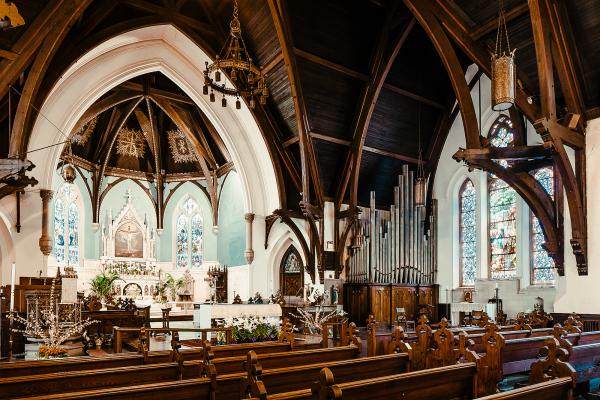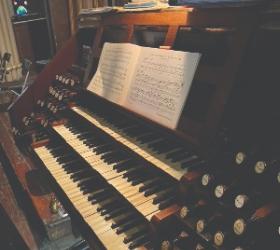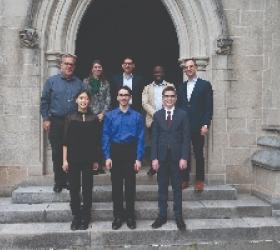
Embracing new, creative approaches, a groundbreaking initiative, “Playing and Preserving: Saving and Activating Philadelphia’s Historic Pipe Organs to Advance Music and Community,” aims to generate public support for the preservation and active use of the organ heritage of Philadelphia, Pennsylvania. The initiative, already underway, builds relationships among congregations, artists, music lovers, organbuilders, and the broader public. Partners for Sacred Places is spearheading the Playing and Preserving venture, supported through a collaborative effort with a team of interdisciplinary partners, including Astral Artists and the Curtis Institute of Music.
Philadelphia’s organs and the sacred places that contain them are some of the city’s greatest treasures—yet, with ever-changing religious landscapes, musical tastes, and technology over the last twenty to thirty years, these buildings and historic organs are at risk. One Philadelphia organist estimated that nearly half of the instruments featured during the Organ Historical Society’s 1996 national convention in Philadelphia are potentially partially destroyed, dormant, or unplayable.
“Our project will turn this problem into an advantage, by leveraging the organ and will amplify one of the most important but typically unappreciated characteristics of sacred places—their auditory and aural qualities—to provide a rich, multi-sensory context for individuals, families, and artists to experience historic places in a powerful way,” said Bob Jaeger, president of Partners for Sacred Places. “This experience will be supported by, among other strategies, place-based storytelling and interactive conversations around what place means to each of us and how it defines our sense of identity and community, as well as engaging history through art.” Playing and Preserving is actively identifying historic organs at risk, activating these instruments through technical assistance and support to the congregations who steward them, and working with project partners and artists in developing concerts that engage the community’s interest in historic preservation through the experience of music.
Assessing the vulnerability
Partners for Sacred Places is collaborating with organ performance students from the Curtis Institute of Music and conducting surveys of approximately fifty historic organs, including many that are at risk in historic sacred places outside of Philadelphia’s urban core. A large part of this process comes with the extensive data being collected on instrument construction, condition, and age.
Also, information is being collected about congregational health, collaborative readiness, openness to the arts, and other key factors. The data—along with audio recordings of the pipe organs and photos of the site—will eventually be available to the public through collaboration with the Organ Historical Society. With this information, artists, performers, and curators can use the database to find venues and instruments that are resources for their practices. Already, the program and its Curtis student partners have visited over forty sites, which have been documented in photographs by a separate team of photographers.
Building capacity to Play and Preserve
Partners for Sacred Places is providing a training and capacity-building program for congregations to help them gain knowledge and skills to better care for their instruments, fundraise for maintenance and capital investments, and develop relationships with artists around mission and vision alignment. Through this program, each congregation is given a complete, professional assessment of their historic organ and technical assistance to promote repairs, conservation, and fundraising help for ongoing maintenance. Technical assistance is provided to help congregations make key, strategic repairs that have helped to make their instruments playable and even more useful for future performances and events.
The training draws on Partners for Sacred Places’ capacity-building programs, including “Making Homes for the Arts in Sacred Places,” which assists congregations in making the most of their properties as assets for ministry. The content is customized to focus on sound stewardship of these instruments, community-partnership building, and community-wide fundraising. In addition to training, this program provides grants to congregations to support the preservation and repair of their historic organs. Each church that receives a grant will match the award with funds they raise using new tools and resources gathered during training, which will help them reach out to a wide network for support.
Pilot performances at St. Mary’s Church, Hamilton Village
Partners for Sacred Places, with Astral Artists, has organized a series of performances and events that highlight historic organs in ways that juxtapose and combine genres and styles of music to engage the local community in preservation and involve musicians of all ages. All concerts welcome families and community members and encourage them to embrace their curiosity about the organ and classical music. These events create a space that allows the organ to return to the center of music making—but with a modern twist. Musicians of all ages perform together with the organ, building community through art and personal connection.
Each performance integrates the story of the historic sacred place, the community content, and the instrument, encouraging audiences to move beyond passive participation toward personal engagement and to reflect on what they hear, see, feel, and how music and storytelling affect their perception of the place. The concerts are all preceded by child-friendly “Experience Stations” that cover topics like organ education, performance practices, rehearsal techniques, and cross-genre program planning.
Further, Astral Artists have begun mentoring students at Play On Philly during four short residency visits, building musical skills as well as vibrant relationships between young musicians and world-class musicians. The first concert featured Astral Artists and Play On Philly musicians, drawing a diverse crowd that enjoyed the hands-on approach to learning about historic organs. Artists involved included Project Fusion, a saxophone quartet; Michael Lawrence, director of music/organist/choirmaster at St. Mary’s Episcopal Church, Hamilton Village; and the Play on Philly Wind Ensemble. Another program featured Thomas Mesa, cello; Greg Zelek, organ; and the Play On Philly Cello Ensemble. On December 21, a concert is planned featuring Mesa and Zelek again, joined by Chrystal E. Williams, mezzo-soprano, and the Play On Philly Symphony Orchestra.
All of these concerts occur at St. Mary’s Episcopal Church, Hamilton Village, a historic congregation that completed the present Gothic Revival structure in 1873. Following a fire in 1936, several alterations were made to the edifice, including installation of the present organ, Aeolian-Skinner Organ Company Opus 963, finished in the fall of 1937. The church, still an independent congregation, is now surrounded by the University of Pennsylvania campus.
“The initiative will allow Partners for Sacred Places and its collaborators to advance their work by bringing the performing arts into preservation as a new way to offer sensory experiences that increase the appreciation of historic architecture and create a model for other regions to follow,” said Bob Jaeger.
The Playing and Preserving project is led by a committee including Jonathan M. Bowen, organist, St. Luke & the Epiphany Episcopal Church; Michelle Cann, pianist and educator, Keys to Connect; Frederick Haas; Roy Harker, executive director, First Baptist Church of Philadelphia; Dustin Hurt, director, Bowerbird; Dr. Martha Johnson, organist, choirmaster, educator; Alan Morrison, professor, Curtis Institute of Music; Patrick J. Murphy, organbuilder, Patrick J. Murphy & Associates; James Straw, AIA, preservation architect; Dan Visconti, artistic director, Astral Artists; and Karen Whitney, organist and choir director, Salem Baptist Church.
Major support for Playing and Preserving has been provided by The Pew Center for Arts & Heritage, with additional support from the Wyncote Foundation and The 25th Century Foundation. Learn more about this initiative and upcoming events: sacredplaces.org/playing-and-preserving.
Photo: St. Mary’s Episcopal Church, Hamilton Village, Philadelphia, Pennsylvania, Aeolian-Skinner Organ Company Opus 963 (photo credit: Joseph Elliott)




